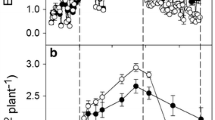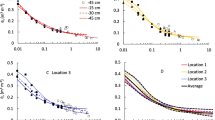Abstract
Seasonal evapotranspiration (ET) was determined for Sultana grapevines grown on their own roots (Own-rooted) or grafted onto Ramsey rootstock (Grafted), and irrigated with water of three salinity levels – low (0.4 dS m–1), medium (1.8 dS m–1) and high (3.6 dS m–1) – during the 1994/1995 growing season in south-eastern Australia. Transpiration (T) was determined from sap flux, soil evaporation (E s) with a model, and soil water (S) with a neutron probe. Total ET for the season was similar for both Own-rooted and Grafted, averaging 382 mm. However, Grafted partitioned a mean of 193.5 mm (50.8%) of the ET through T compared to 146.7 mm (38.4%) by Own-rooted. Daily rates of T were generally low and attained peaks of 1.2 mm (9.9 l per vine) for Grafted and 0.9 mm (7.5 l) for Own-rooted in late November, and changed very little until after harvest in February. In contrast to T, the E s rate was consistently higher for Own-rooted than for Grafted from November onwards, and at the end of the season totalled 237 mm for Own-rooted compared to 187 mm for Grafted. Differences between Own-rooted and Grafted in their partitioning of ET into T and E s were associated with their canopy development. Grafted had a higher rate of canopy development than Own-rooted, and in mid-season, the former intercepted about 50% more incident radiation than Own-rooted. The crop factors, i. e. ratio of water use to evaporative demand, based on ET were similar for both vine types with an average seasonal value of 0.25, but when based on T were 0.12 for Grafted and 0.10 for Own-rooted. The ratio of fresh fruit weight to total water used at harvest, i. e. crop water use efficiency (CWUE), based on ET, had a mean of 86 kg mm–1 ha–1 for Grafted and 43 kg mm–1 ha–1 for Own-rooted, and when based on T, was 165 and 115 kg mm–1 ha–1, respectively; however, supplementary data obtained during the 1993/1994 season, indicated a CWUE based on T of 294 and 266 kg mm–1 ha–1 for Grafted and Own-rooted, respectively. Salinity did not have significant effects on canopy development and water use for most of the 1994/1995 growing season. The study shows ET and crop factors for the drip-irrigated grapevines to be much lower than previously reported for this district.
Similar content being viewed by others
Author information
Authors and Affiliations
Additional information
Received: 6 May 1996
Rights and permissions
About this article
Cite this article
Yunusa, I., Walker, R. & Blackmore, D. Characterisation of water use by Sultana grapevines (Vitis vinifera L.) on their own roots or on Ramsey rootstock drip-irrigated with water of different salinities. Irrig Sci 17, 77–86 (1997). https://doi.org/10.1007/s002710050025
Issue Date:
DOI: https://doi.org/10.1007/s002710050025




